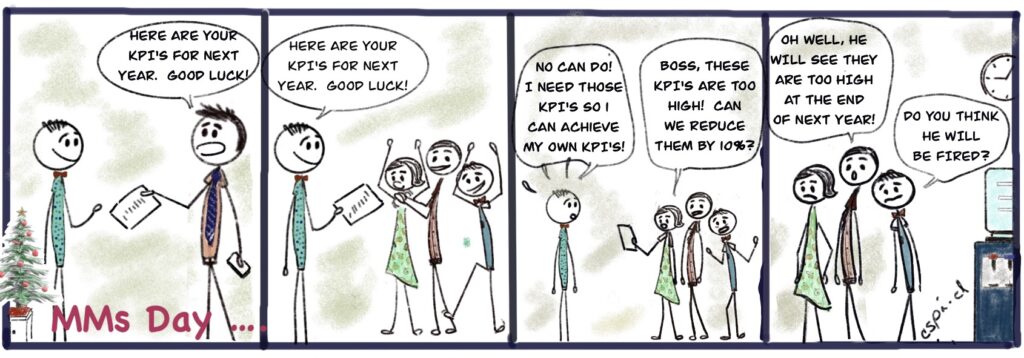
These thoughts are confined to performance measures of individuals and teams.
Thought one:
A performance measure is a tool.
Thought two:
Performance can be measured as an outcome, for example, the final score in a basketball game. Performance can also be measured as a data point on the journey to an outcome. When performance is measured as an outcome it is known as a lagging measure. Think of the idea that something is lagging behind meaning that it is reflects the results of past performance. In the basketball game the performance of the team on the court will be the past performance of the final score. Lagging measures for the most common used in KPI’s and general business reporting because they are easy to record impossible to influence as the performance has already been enacted.
A performance measure as a data point on the journey to an outcome provides the ability to take action if the performance data point is not acceptable. This is called a leading measure. An example is measuring the progress of a project in time. If 20% of the project was estimated to be completed by a certain date and that did not happen, then, action can be taken to speed up the project to meet the next planned date and ultimately the target date for the end of the project.
In summary, a leading performance measure does not allow for influencing the end result, whereas a lagging performance measure allows action to take place before the end result occurs.
Thought three:
Many KPI’s (Key Performance Indicators) are used, primarily, as leading indicators in order to judge the success or failure of an individual or team. Often these KPI’s are negotiated for a year and used in an annual performance review conversation.
Thought four:
KPI’s are both motivational and restrictive. They are motivational if the person or team is aware that they will be judged on the measure. They become restrictive because, during the negotiation of KPI’s, it will be argued that perfection would be an unreasonable measure. 100% seldom appears in KPI’s. For example, a KPI built on customer’s satisfaction always have a measure less than 100%. Let us say that the measure is 95%. What this implies is that 5% of the customers will be unhappy and that is OK! The problem arises in the restriction to the motivation and thinking of the individual or team being measured. They will never hold 100% as the possible achievement of customer satisfaction.
Thought five:
Managers frequently perceive KPI’s as their best friend. They can use them as a threat to the individual or team, thinking that threats of failure are motivational. They use KPI’s as a non-argumentative way of giving performance feedback. The individual or team cannot argue as KPI’s are frequently binary. It was achieved or it wasn’t.
Thought Six:
It is ideal if individual and team measures primarily use lagging measures to ensure that actions are continually being taken to achieve the outcome, which is the leading measure. In this ideal, the lagging measures will be the subject of discussion on a frequent basis, as opposed to an annual discussion on a single data point, namely, the current KPI measure
Thought seven:
There is an alternative to how a manager motivates the achievement of results, other than KPI’s. This requires a mind shift in how results are achieved. The purpose of this mind shift is to solve the problem of less than perfect outcomes, include agile principles, use lagging measures and motivate staff. The overall measure used for this is OKR. Abbreviation stands for Objectives Key Results.
It’s useful to think about the “OKR process”, than, simply, think of the “objective” and the “key result” bits. Static goals need to be reviewed and revised as things change quickly. OKR’s combine clear objectives with three or four specific, measurable results. These results are expected to be reached in a maximum of three months. Reviewing the progress toward these results is what differentiates OKR’s.
This is a key principle in agile work. Know the overall objective and set short term results as needed.
The mind shift that is needed is an acceptance that, one, short term results that are developed include a degree of challenging stretch. This avoids the lowering of targets in order to increase the likelihood of the target being met, as happens in KPI’s. Two, given the inbuilt stretch it is anticipated that not all results will be achieved. When this happens the question asked is , “given that this has happened, what is possible now?”. This will lead to a conversation, during the review, looking for the root cause of having missed the result or, maybe, the constraint to its achievement. Decisions are made on changes, results are adjusted, or new results developed, for the next three month period.
Thought eight: If we ignore the use and rules of the terms KPI’s and OKR’s we are left with the need for a performance management system that is:
- Measured, unambiguous, motivating and stretch.
- Reviewed on a regular, relatively short timeframe.
- Linked to a clear objective.
- Tolerates the incomplete achievement of a result.
- Adapts to changing circumstances.
Thought nine:
While I do not recommend the abolition of KPI’s, I do recommend that KPI’s are adjusted to meet the requirements of thought eight. This means that while an overall objective for an individual or team might have 100% as a target, the target itself, is not the KPI. The KPI is will be short term results expected in order to move the company towards the 100% target.
Obviously, the annual performance review will change in form as they have likely been several reviews during the year and the individual and team will already be clear on how well they have achieved their results.
Thought Ten:
There is a place in the system for KPI’s which, in fact are SLA’s. There will be many employees who are doing repetitive work such as encoding. Things like accuracy and speed are important measures to use to keep the operation on track. Even at this level an objective should be 100% of what is being measured. Attached to this could be minimum SLA’s (disguised as KPI’s). The idea of using a minimum SLA is to give the message that 100% is still the objective. One can celebrate when the minimum SLA has been, and, the review periods can focus on ”how can we do even better?”
Examples
SLA KPI:
Objective: 100% accuracy
KPI: Minimum accuracy over a month 96%
OKR:
Objective:
Increase customer satisfaction among teenagers
Results:
- ZOOM conversations with 100 teenage customers.
- Study social media to determine trending concerns and language of teenagers in target market.
- Analyze complaints from teenage subset of customers over last 6 months.

